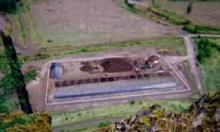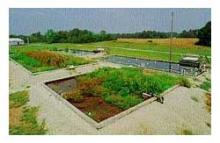Data provider
Budapest University of Technology and Economics, Department of Applied Biotechnology and Food Science, Environmental Microbiology and Biotechnology Group
Contact details
Compulsory sheet of the technology
Financing of the project
Application sphere
- Explosives
- 1,3,5-trinitrobenzene
Description of environmental risk
- Explosives
- cyclotetramethylene-tetranitramine
Description of environmental risk
- Explosives
- trinitrotoluene
Description of environmental risk
- Explosives
- other explosive
Description of environmental risk
- Volatile (nonhalogenated) organic compounds
- 2,6-dinitrotoluene
Description of environmental risk
- Volatile (nonhalogenated) organic compounds
- 2,4-dinitrotoluene
Description of environmental risk
Information on the technology
A murva alapú és a lagúna alapú gyökérzónás tisztítási rendszerek működésének alapja, hogy a medencék nagyjából 10 napig visszatartják a felszín alatti vizet, melynek áramlási sebessége 5 gallon méterenként, s ez alatt a telepített növények gyökérzetükön keresztül felvesztik a szerves tápanyagokat (szennyezőket) a vízből. A kavicságyas módszernél két 4 láb mélységű kavicságyat kötnek sorba, melyekbe növényeket telepítenek. Az első medence anaerob, a második aerob működési elvű. A lagúnarendszerű módszernél két 2 láb mély medencét kötnek sorba és vízinövényeket telepítenek bele.
Újdonság a robbanószerekkel kezelt felszín alatti víz kezelése tavas, gyökérzónás fitoremediációs módszerrel.
Technology classification
- phytoremediation
- ground water rhizotreatment
Technology-monitoring
Costs of the technology
SWOT (evalaution based on scores)
SWOT (evaluation in words)
A robbanóanyag-alapanyagokat, pontosabban azok nitrogén illetve foszfortartalmát hatékonyan eltávolítja. A működtetési költségek nem túl magasak. Természetközeli megoldás. A láp kialakításával élőhelyet teremt. Ökológiai megoldás, nem tájidegen. Nincs vegyszerhasználat. Nincs melléktermék. Nem igényel sok karbantartást, automatizálható.
A beruházási költség nagyon magas. Nagy a helyigénye. A szerves szennyezőkön kívül mást nemigen köt meg. Időigényes megoldás. Toxikus szennyezők talajvízbe kerülése esetén a remediáló növényszervezetek elpusztulhatnak. A lagúnarendszer kevésbé bizonyult hatékonynak. A módszer hatékonysága nagyban függ a talaj, talajvíz, szennyezők összetételétől, pH-tól, hőmérséklettől, meteorológiai viszonyoktól.
A mérések alapján melegebb éghajlaton még hatékonyabb a működés. A további fejlesztésekkel, a folyamatok ellenőrzés alá vonásával a veszélyek kiküszöbölhetők lennének.
Sok az előre nem látható, ki nem küszöbölhető veszély: pl.: fertőzések kialakulása (a lagúnarendszernél már volt példa súlyos ebihalpusztulásra), illetve a költségcsökkentés igénye a kivitelezés minőségét ronthatja.
Completed applications
Volume of the moved phase
Kétféle gyökérzónás tisztítási módszert vizsgáltak a projekt során, egy murva alapú és egy lagúna alapú rendszert. A demonstráció 3 szakaszban zajlott: A terület átvizsgálása és javíthatósági felmérése (I), Tervezés, konstrukció, és 16 hónapon keresztüli monitorozás (II), illetve hosszú távú nyomonkövetés és optimalizálás. A rendszer működését 2 éven keresztül vizsgálták, s úgy találták, hogy a lagúna alapú módszer nem volt elég hatékony, ezzel nem tudták elérni a kitűzött célokat, ellenben a murva alapú rendszer kiválóan működött.
- Explosives
- trinitrotoluene
Description of environmental risk
- Explosives
- other explosive
Description of environmental risk
- Explosives
- cyclotetramethylene-tetranitramine
Description of environmental risk
- Explosives
- other explosive
Description of environmental risk
Publications, references
Sikora, Almond, Behrends, Hoagland, Kelly, Phillips, Rogers, Summers, Thornton, Trimm, and Bader; 'Demonstration Results of Phytoremediation of Explosives-Contaminated Groundwater Using Constructed Wetlands at the Milan Army Ammunition Plant, Milan, Tennessee;' December 1998; USAEC Report Number SFIM-AEC-ET-CR-97059.
Kadlec and Knight; 'Treatment Wetlands;' 1996; CRC Lewis Publishers; Boca Raton, FL.
Morely Locandro, Anyanwu, Schweighauser, Humber, Okusu, Zirps, and McKown; 'Milan Army Ammunition Plant Northern Boundary Groundwater - Focused Feasibility Study, Final Document;' June 1994; USAEC Report; Task Order No. 2 Total Environmental Program Support Contract Number DAAA 15-91-D 0014.
Sikora, Behrends, Phillips, Coonrod, Bailey, and Bader; 'A Microcosm Study on Remediation of Explosives-Contaminated Groundwater Using Constructed Wetlands. Bioremediation of Surface and Subsurface Contamination;' 1997; Annals of the New York Academy of Sciences
Walsh; 'Environmental Transformation Products of Nitroaromatics and Nitraamines: Literature Review and Recommendations for Analytical Method Development;' 1990; U.S. Corps of Engineers, Cold Regions Research & Engineering Laboratory; Special Report 90-2.
Rieger, Knackmuss; Spain, Ed.; 'Basic Knowledge and Perspectives on Biodegradation of 2,4,6-trinitrotoluene and Related Nitroaromatic Compounds in Contaminated Soil;' 1995; Environ. Sci. Res., Vol. 49; 1-18; Biodegradation of Nitroaromatic Compounds.4. McCormick, N. G., J. H. Cornell, and A. M. Kaplan; 'The Fate of Hexahydro-1,3,5-trinitro-1,3,5-triazine (RDX) and Related Compounds in Anaerobic Denitrifying Continuous Culture Systems Using Simulated Wastewater;' 1984; U.S. Army Natick Research & Development Center, Tech. Rep. Natick/TR-85/008.
Steiner, Watson, and Choate; Moshiri, Ed.; 'General Design, Construction, and Operation Guidelines for Small Constructed Wetlands Wastewater Treatment Systems;' 1993; Constructed Wetlands for Water Quality Improvement, pp 499-507, Lewis Publishers.
Best, Sprech, Larson, and Fredrickson; 'Environmental Behavior and Fate of Explosives in Groundwater from the Milan Army Ammunition Plant in Aquatic and Wetland Plants Fate of TNT and RDX,' February 1998; USAEC Report Number SFIM-AEC-ET-CR-97060.

